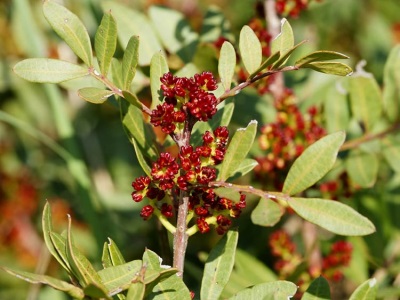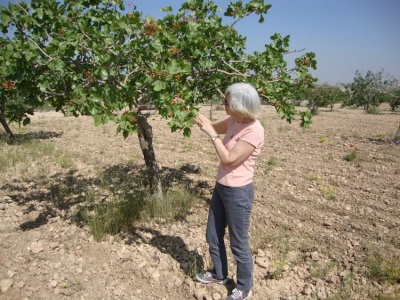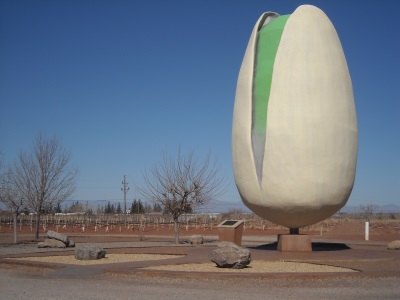Pistachio

Pistachio belongs to the Sumac family and is represented by both shrubs and trees. The plant is common in the subtropics and partially found in the tropics. The most valuable part of the pistachio is its fruit.
By themselves, pistachios are not nuts, but they are all called nuts.
Latin name - Pistacia.

Appearance
Pistachios grow as shrubs but also as deciduous and evergreen trees. Their height is 7-10 m.
The fruits of such shrubs and trees are stone fruits, their length is up to 12 cm and width is up to 1 cm. They have an ovoid shape and an elongated seed inside.
The pericarp is thin and reddish, easily separated from the fruit. The shell most often cracks when the nut ripens.
The seed is greenish, tasty. Plants begin to bear fruit in late autumn.
Pistachio trees are distinguished by thick gray bark, pinnate, trifoliate or simple leaves, as well as red-yellow flowers collected in panicles that appear before the leaves.

The roots of pistachio trees are large, two-tiered and can grow up to 15 meters deep and up to 40 meters wide.
The leaves are leathery, consist of 3-5 leaflets in the shape of an ellipse.
Among the trees, males and females are distinguished. The pollen of one male tree is enough to pollinate 8-12 female trees.
Life expectancy is about 1000 years.

Unopened pistachios contain too much essential oil and should not be eaten.
Kinds
Up to 20 types of pistachios are known, the main ones are:
- Atlantic. It is used to obtain resin, as well as a rootstock for real pistachio.
- Real. Trees with a height of 9 meters or more, which have a spherical dense crown, often several trunks, a deep root, leaves falling for the winter. The plant lives up to 300 years. The fruits of such pistachios are distinguished by a pleasant taste and a length of up to 2 centimeters.
- Dull (wild). A drought-resistant plant growing in the Caucasus, Asia, the Crimea and other places. It is usually represented by trees, the height of which is 8-10 meters, but it also happens in the form of multi-stemmed bushes. The fruits are edible, but smaller than the fruits of a real pistachio. Plants make crafts from wood.
- Chinese. It is characterized by the greatest frost resistance and a height of up to 15 m.
- American (also called Mexican).
- Turpentine. Trees up to five meters high. They can be found in Sochi, Tbilisi and Baku.
- Mastic. Represented by small trees or bushes growing to a height of up to three meters. The fruits of the mastic tree are used to produce oil. The plant is also in demand for creating a hedge. Mastic pistachios are tapped into mastic, which can be used to make putties, paints or varnishes.

Where does it grow
The homeland of the plant is Iran, Afghanistan and the countries of Central Asia. Here it can also be found in the wild.
Nowadays, pistachio trees are grown in many countries of the world with a warm climate: in the Crimea, European countries, the USA, Asian countries, northwestern regions of Africa, Turkey, Australia. Wild plants can be found in Tajikistan, Uzbekistan and Kyrgyzstan.

How it grows
Reproduction of pistachios in nature occurs by seeds, as well as shoots.The plant is cultivated using propagation by cuttings.
Wild pistachios are noted for their resistance to both drought and frost. The plant prefers rocky and stony soils. It can gain a foothold on a cliff or slope thanks to a developed root system. Often, pistachio trees grow singly (large thickets of trees are very rare).
Collection and preparation
Fruits are formed in large quantities on trees of 7-10 years of age, and the maximum productivity is noted in pistachio trees that have reached the age of 20. In ripening nuts, the shells partially open with a click.
In wild plants, the fruits are not very large (100 grams weighs 50-60 grams). On fruiting trees, up to 30% of drupes can be empty (no kernels). Yields vary by region and by variety.
The fruits from the trees are harvested in August and September:
- They are cut off manually or shaken off with the help of special poles on the canvas.
- Fruit picking is carried out at night, because during the day aromatic oils are released from pistachio leaves, causing dizziness.
- Nuts are peeled from the shell immediately so that the shell does not darken.
- The peeled fruits are dried in the sun for about 5 days.
- You need to store dried pistachios in a cool place - at a temperature of + 2 + 10 degrees, the nuts will not deteriorate for up to a year, and at 0 ° C for up to four years.

Peculiarities
- Pistachio fruits differ from other nuts in their greenish color and partially open shell, so they do not need to be peeled before salting and frying.
- Pistachios have a very pleasant aroma.
- Nuts have a fairly high nutritional value.
- Due to the high protein content, pistachios are recommended for vegetarians and those who want to lose weight.
- Valuable oil is also obtained from pistachio fruits.

How to choose and where to buy
The fruit of the pistachio tree is almost always sold in shell.
By size they are divided into:
- small,
- standard,
- medium,
- large.
Ripe pistachios are distinguished by the green color of the kernels and the presence of an open shell.

Tips for choosing pistachios:
- The shell should be cream or off-white.
- Nuts should be uniform in size, without cracks and not flattened.
- There should be no spots on the fruits.
- Don't buy nuts if they have a moldy, musty or rancid smell.
For the food industry, in addition to whole pistachios, halves of nuts, quarters and pistachios in the form of small pieces are sold.
Pistachio kernels quickly absorb foreign odors, so they should be stored separately from other products.

It is advisable that the pistachios you buy (if we are talking about unsalted nuts) be well packaged and stored in the refrigerator.
To lengthen the shelf life and prevent spoilage, nuts are roasted, sweetened or salted.
The reddish shell indicates pre-pickling of the pistachios.
See below for details.
Characteristics
- Pistachios have a fairly high calorie content, a high content of fats, vitamins, amino acids and minerals.
- Pistachio fruits are recommended during the recovery period and in case of exhaustion, as well as for athletes and with great mental stress.
- Regular consumption improves heart and liver function.
- Due to the ability to enhance potency and have a positive effect on sperm, these nuts are considered an aphrodisiac.

Nutritional value and calories
In 100 grams of pistachio fruits:
- 556 kcal;
- 44.4 g fat;
- 20.6 g of proteins;
- 17.7 g of carbohydrates;
- 10.3 g fiber.
Nutrient ratio: up to 68% fat, up to 20% protein, up to 25% carbohydrates.
How many can you eat per day?
The daily preventive intake of pistachios is 10-15 nuts per day, and the therapeutic one is no more than 100 g.
Chemical composition
Pistachios are rich in:
- amino acids;
- starch;
- fatty acids - oleic, linoleic, palmitic, stearic and others;
- sucrose;
- glycerides;
- vitamins E, A, B6, B1, folic acid;
- minerals (phosphorus, magnesium, manganese, copper, potassium);
- tannin;
- carotenoids - zeaxanthin and lutein.
Beneficial features
- Pistachio helps maintain vitality, so it is recommended for fatigue and weakness.
- Fruits are an environmentally friendly product, since their processing does not include extraneous interference.
- Nuts are rich in antioxidants, so their use normalizes the functioning of the cardiovascular system, helps to rejuvenate the body and lowers cholesterol.
- Expectorant and antitussive action.
- Pistachio oil increases potency, accelerates the acquisition of a tan, tones, strengthens the body, and has a slight laxative effect. It is also used in cosmetology and promotes wound healing.
- Regulate carbohydrate metabolism.
- They have a positive effect on the organs of vision, restore visual acuity.
- Improve the condition of the skin, hair, nails and teeth.
- Prevent the development of diabetes.
- They have a rejuvenating effect.
- They are good cancer prevention.
- Increase the potency of men.
See below for details.
Harm and contraindications
- Overdose may cause dizziness and nausea.
- Pistachio oil is not recommended during pregnancy due to its laxative effect.
- These nuts are considered highly allergenic. In case of allergies, they should be used with caution.
- Eating salted pistachios can cause an increase in blood pressure.
- Children's age, because may lead to the development of diathesis.
- Acute forms of diseases of the gastrointestinal tract, kidneys.
- Salted pistachios are contraindicated in hypertension due to the presence of a large amount of salt.
Oil
From the seeds, high-quality oil is obtained, which in its properties is not inferior to olive oil. It is used in cooking and for the production of high-quality varnish.
It is very useful to add pistachio oil to bathing water (1 tbsp per bath of water).

The oil obtained from pistachio fruits is used:
- inside to strengthen immunity (daily 1-2 teaspoons);
- for lubrication of the skin affected by the fungus, as well as for dermatitis (treat 4 times a day);
- in order to eliminate acne, diathesis, eczema and allergic rash;
- for hair care to give them shine, silkiness and smoothness;
- as a means of skin care (especially sensitive);
- to protect the skin in cold and windy weather;
- to strengthen the nail plates;
- as a massage oil (used as a basis for aroma oils);
- for masks (can be mixed with other oils, such as almond or avocado, as well as with EO);
- as a sunscreen;
- to eliminate freckles and age spots.
Pistachio oil can enrich any skin care cosmetics. To do this, simply add a few drops of oil to the usual remedy.
Application
In cooking
- Pistachios are consumed raw, roasted or salted.
- They are widely used in the confectionery industry, adding to sweets, chocolate, creams, cookies, pies.
- They are seasoned with meat and fish dishes, they are added to salads and pates.
- Crushed pistachios are stuffed with game, pigs or poultry.
- Especially popular is pistachio ice cream, which has a green color and a pleasant nutty taste.
- Roasted and salted, it is a frequent addition to beer.
- Pistachios are added to oriental sweets.






Pasta with pistachios
To prepare this delicious gourmet dessert, take 300 g of cottage cheese and wipe through a sieve. Add 50 g of sugar, vanillin to taste, one egg, 50 g of butter and chopped peeled pistachios to the cottage cheese, then rub everything well. Pour 200 g of heavy cream into the resulting mixture, after mixing, put on gauze and put under pressure in the refrigerator for a day.

Salad
Boil and cut into 200 gr. chicken breasts, grate 200 gr. cheese, 1 bell pepper cut into strips. Salt everything, add 2 tbsp. l. sour cream and mix. Sprinkle salad 70 gr. pistachios.

Pistachio ice cream
Take 200 gr. shelled unsalted pistachios. Finely chop a handful of them, grind the rest in a coffee grinder to a state of flour. In a separate container, beat 1 egg and 120 gr. sugar and add to them 200 ml. warmed 20% cream.
Take another 300 ml. cream and beat them with a blender to a state of steep foam. Combine everything and put either in an ice cream maker for 40 minutes, or put in a freezer for 3-4 hours. Arrange the finished ice cream, garnish with chopped pistachios and mint leaves.

In medicine
- Roasted and soaked pistachio kernels are used for digestive disorders. Effective and infusion of them.
- Nuts boiled in wine are recommended for snake bites as a detoxifier.
- A decoction of pistachios (1 to 10) helps with anemia, vomiting, asthenia, and gastrointestinal diseases.
- With bronchitis, pistachios have an antitussive effect.
- Studies have confirmed that eating pistachios helps to normalize cholesterol and blood sugar levels. Scientists have also found that daily consumption of these nuts reduces the risk of cancer.
- Pistachios are prescribed after serious illnesses, as well as under heavy stress (physical or mental).
- These nuts have been shown to reduce pain in hepatic or gastric colic.
- They have a strong anti-sclerotic effect.

Pistachios are recommended due to their medicinal properties to be taken when:
- depression,
- atherosclerosis,
- coughs and colds,
- tuberculosis and other diseases of the lungs and bronchi,
- impotence,
- with low and weak sperm motility,
- with diseases of the gastrointestinal tract,
- with diseases of the liver and gallbladder,
- anemia,
- diseases of the joints and spine,
- during pregnancy - relieve nausea with toxicosis. But pistachio oil should not be consumed during pregnancy!
- lactating women.
In order to treat and prevent pistachios, it is better to use them raw, without salt and sugar.
With a decrease in sexual desire and impotence
Within a month, use 100 g of real pistachios.
To prevent further development of diabetes mellitus and atherosclerosis
Eat 50 grams daily. nuts.
Renal colic
20 gr. pistachio fruit pour 1 tbsp. boiling water. Bring to a boil and cook for a few minutes.
Strain the decoction and drink it.
With a general weakness of the body, still eat the therapeutic norm of pistachios (no more than 100 gr.) During the day for 2-3 doses.
For constipation and poor digestion, gastritis and stomach ulcers
On an empty stomach in the morning, take 1-2 tsp. pistachio oil. The course of treatment is 1 month.
Skin diseases
For skin diseases - psoriasis, ulcers, wounds, eczema 3-4 times a day, lubricate with pistachio oil. The course of treatment - until recovery.
Leaves
The leaves contain a large amount of tannins. They are called "buggun".

Decoctions of them are used to treat:
- bedsores,
- burns
- ran,
- ulcers,
- stomatitis and other inflammations in the mouth.
In dried form, these leaves are included in the mixture of Turkmen spices and are introduced into an almost ready dish 7 minutes before readiness.
When losing weight
Despite the relatively high calorie content, the consumption of pistachios does not lead to excess weight.
Studies have shown that nut lovers often have less body weight than people who don't eat them. The fact is that not all calories are absorbed in the body completely. At the same time, pistachios stimulate the metabolism. Of course, you need to use them for weight loss only fresh.
The information of historians also confirms the benefits of pistachios for weight loss - Persian healers prescribed oil from these nuts to those who wanted to reduce their weight.
At home
- The wood of pistachio trees is in demand in carpentry for its strength and density.
- Resin is obtained from pistachio trees by tapping.
- The tannins extracted from the leaves are used in the pharmaceutical and leather industries. They also produce dyes used in textiles.
- Leaves and branches of pistachios are used by florists.
- The cake remaining after oil production is fed to poultry and livestock.
Varieties
Turkey is one of the leading producers of pistachios in the world. Turkish varieties are of good quality and pleasant taste. Among them, one of the most accessible and oldest is the Antep variety. Nuts of this variety are small, darker than other varieties and less open, but more fragrant and tasty.
Iran is another major producer of pistachio nuts.
The main Iranian varieties are:
- Fandugi (round nuts, which are most often exported);
- Akbari (long nuts, which are the most expensive variety);
- Ahmad-agkhai (long pistachios, especially in demand in East Asia);
- Badami (nuts with a shape similar to almonds);
- Kale-guchi (half-open wide fruits).
Watch the following videos of the program "Health of the Nation" - you will learn a lot of interesting things about pistachios.
cultivation
Pistachio is cultivated only in subtropical regions, since the plant needs warmth and the absence of frost to grow. To obtain fruits, trees of different sexes need to be planted nearby. Pistachios grow well in sandy soils. Plants need to be watered very rarely. Trees grown from cuttings bear fruit from 7-8 years of age, and plants grown from seeds - only from 12 years.

Interesting Facts
- Pistachios and champagne are served to Nobel laureates who come to celebrate receiving the awards.
- The pistachio tree is written about in the Bible. It is believed that this tree has been feeding people with its fruits for over 9,000 years.
- In Russia, most often these nuts are consumed with beer.
- Gourmets like to eat pistachio nuts with cream cheese and strawberries.
- Their ancient name is "magic nut".
- The Chinese call them "lucky nuts".
- Every year on February 26, World Pistachio Day is celebrated.
- In Turkey, at the entrance to Gaziantep, there is a monument to pistachio.

Not only Turkey distinguished itself: in Spain, in New Mexico, there is also a similar monument.



















This is my favorite nut. It seems to me that there is nothing tastier than pistachios!
I love pistachios, but now they are expensive, and so delicious.
Delicious and healthy.